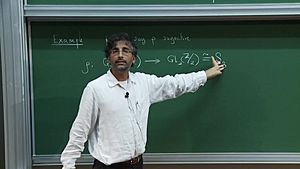Akshay Venkatesh facts for kids
Quick facts for kids
Akshay Venkatesh
|
|
|---|---|

Venkatesh in 2014
|
|
| Born | 21 November 1981 New Delhi, India
|
| Nationality | Australian |
| Alma mater | Princeton University University of Western Australia |
| Known for | Mathematical Work, Former Child Prodigy |
| Spouse(s) | Sarah Paden |
| Awards | Salem Prize (2007) SASTRA Ramanujan Prize (2008) Infosys Prize (2016) Ostrowski Prize (2017) Fields Medal (2018) |
| Scientific career | |
| Fields | Mathematics |
| Institutions | Institute for Advanced Study (2005–2006, 2018–present) Stanford University (2008–2018) Courant Institute of Mathematical Sciences (2006–2008) |
| Doctoral advisor | Peter Sarnak |
Akshay Venkatesh (born November 21, 1981) is an Indian Australian mathematician. He is a professor at the School of Mathematics at the Institute for Advanced Study. He studies different areas of mathematics, including how numbers are counted and how patterns appear in complex number systems.
Akshay was the first Australian to win medals in both the International Physics Olympiad and the International Mathematical Olympiad. He achieved this amazing feat when he was only 12 years old.
In 2018, he received the Fields Medal. This award is often called the "Nobel Prize of mathematics." He earned it for combining different math ideas like number theory and geometry to solve difficult problems. He is the second Australian and the second person of Indian background to win this prestigious medal.
Contents
Early Life and Education
Akshay Venkatesh was born in Delhi, India. When he was two years old, his family moved to Perth, Australia. He went to Scotch College for his schooling. His mother, Svetha, is a professor who teaches computer science.
Akshay was a child prodigy, meaning he was very talented from a young age. He took extra classes for gifted students in math competitions. In 1993, at just 11 years old, he competed in the 24th International Physics Olympiad and won a bronze medal.
The next year, he focused on mathematics. He won a silver medal in the 6th Asian Pacific Mathematics Olympiad. Then, he won a bronze medal at the 1994 International Mathematical Olympiad in Hong Kong. He finished high school that same year, just before turning 13.
Akshay then started studying at the University of Western Australia. He was the youngest student ever to attend the university. He finished his four-year degree in only three years. At 16, he became the youngest person to earn top honors in pure mathematics from the university. He also received a special award for being the most outstanding graduate in science and engineering fields.
His Career in Mathematics
Akshay began his PhD (a high-level university degree) at Princeton University in 1998. His advisor, or mentor, was Peter Sarnak. Akshay finished his PhD in 2002.
After that, he worked at the Massachusetts Institute of Technology. He also received a special fellowship from the Clay Mathematics Institute from 2004 to 2006. He then became a professor at the Courant Institute of Mathematical Sciences at New York University.
From 2005 to 2006, he was a member of the School of Mathematics at the Institute for Advanced Study (IAS). In 2008, he became a full professor at Stanford University. In August 2018, he returned to the IAS as a permanent faculty member.
Awards and Achievements
Akshay has received many important awards for his work in mathematics.
- In 2007, he was given the Salem Prize. This award is for young mathematicians who do excellent work in the field of Fourier series, which is about breaking down complex waves into simpler ones.
- In 2008, he won the SASTRA Ramanujan Prize. This prize honors mathematicians under 32 years old who have made great contributions to areas of math influenced by the famous Indian mathematician, Srinivasa Ramanujan.
- In 2016, he received the Infosys Prize in Mathematical Sciences. This was for his wide-ranging and creative contributions to modern number theory.
- In 2017, he was awarded the Ostrowski Prize. This prize is given every two years for outstanding achievements in pure mathematics.
The Fields Medal
In 2018, Akshay Venkatesh was awarded the Fields Medal. This is one of the highest honors a mathematician can receive. He was recognized for combining different areas of mathematics, like number theory and geometry, to solve long-standing problems.
Professor Michael Giudici from the University of Western Australia said that Akshay's work is very complex and hard to explain simply. Australian mathematician Adam Spencer noted that mathematicians are crucial for the future, especially in areas like computer coding and artificial intelligence. Professor Geoff Prince, director of the Australian Mathematical Sciences Institute, praised Akshay as an innovative leader whose work has wide-ranging effects on mathematics.
The Fields Medal committee said that Akshay has made "profound contributions" to many areas of mathematics. They noted that he solved many old problems by combining ideas from different fields that seemed unrelated. He also found new ways to look at classic problems and made important predictions.
Akshay's work often uses "dynamics theory," which studies how things move, to solve problems in "number theory," which is the study of whole numbers and prime numbers. He also uses "representation theory," which helps understand abstract math ideas, and "topology theory," which looks at shapes that can be stretched or twisted.
When he received the award, Akshay said that even though math can be challenging, there are moments when you feel lucky to work with it. He described a feeling of "transcendence," like being part of something truly meaningful.

